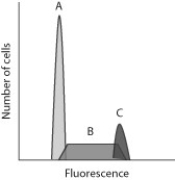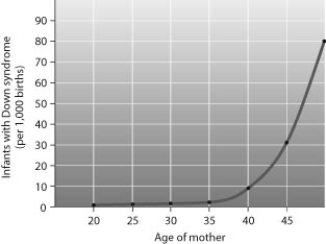A) In animals, meiosis only occurs in the ovaries and testes.
B) All sexual life cycles involve an alternation of diploid and haploid stages.
C) Mitosis produces daughter cells with half the number of chromosomes as the parent cell.
D) A normal human zygote has 46 chromosomes.
Correct Answer

verified
Correct Answer
verified
Multiple Choice
If a chromosome fragment breaks off and then reattaches to the original chromosome but in the reverse direction, the resulting chromosomal abnormality is called a(n)
A) deletion.
B) inversion.
C) translocation.
D) reciprocal translocation.
Correct Answer

verified
Correct Answer
verified
Multiple Choice
Eukaryotic cells spend most of their cell cycle in which phase?
A) interphase
B) prophase
C) metaphase
D) telophase
Correct Answer

verified
Correct Answer
verified
Multiple Choice
Cancer is not usually inherited because
A) the chromosomal changes in cancer are usually confined to somatic cells.
B) people with cancer usually die before reproducing.
C) the causes of cancer are not usually genetic.
D) the cancerous cells usually interfere with the ability to produce gametes.
Correct Answer

verified
Correct Answer
verified
Multiple Choice
Plants grow taller through mitosis at the tips of their shoots (above ground) and at the tips of their roots (below ground) . Here are two samples of tissue taken from a grass plant, one from the tip of the root and one from the mid part of the plant. -From the data shown what can you conclude about the amount of time these plant cells spend in various stages of the cell cycle?
A) Cells spend more time in cytokinesis than in synthesizing new DNA during chromosomal duplication.
B) Metaphase is the longest stage of mitosis.
C) Metaphase lasts about twice as long as anaphase
D) Cells spend less time in prophase than any other of the stages of mitosis.
Correct Answer

verified
Correct Answer
verified
Multiple Choice
A technique called flow cytometry is used by scientists and researchers to count or sort cells based on specific properties. By labeling cellular DNA with a fluorescent dye, flow cytometry can sort cells based on the amount of DNA present, thereby making it possible to distinguish between cells that are in different stages of the cell cycle. Flow cytometry is especially useful to the medical community because it can help with the diagnosis of certain types of cancers. Below is a typical set of data that you might obtain when running a flow cytometry experiment using a sample of healthy skin cells. Use this figure to help you answer the following questions.  After reading the paragraph below, answer the questions that follow.
-Which peak represents cells that contain the most DNA?
After reading the paragraph below, answer the questions that follow.
-Which peak represents cells that contain the most DNA?
A) A
B) B
C) C
D) It cannot be determined from this figure.
Correct Answer

verified
Correct Answer
verified
Multiple Choice
You are observing a single cell under a microscope. You go home for the night, and the next day you see four cells. The four cells look similar, and when you stain them with a dye that binds to DNA they all appear to contain the same amount of DNA as the original cell. What likely happened overnight?
A) The single cell divided once to form four new cells via asexual reproduction.
B) The single cell divided once to form four new cells via sexual reproduction.
C) The single cell divided to form two new cells, and the two new cells each divided to form four total cells, all by asexual reproduction.
D) The single cell divided to form two new cells, and the two new cells each divided to form four total cells, all by sexual reproduction.
Correct Answer

verified
Correct Answer
verified
Multiple Choice
Independent orientation of chromosomes at metaphase I results in an increase in the number of
A) gametes.
B) homologous chromosomes.
C) possible combinations of characteristics.
D) sex chromosomes.
Correct Answer

verified
Correct Answer
verified
Multiple Choice
Which of the following statements regarding Down syndrome is false?
A) Trisomy 21 is the cause of Down syndrome.
B) Down syndrome is the most common serious birth defect in the United States.
C) People with Down syndrome usually have a shorter life span than normal.
D) Down syndrome is least likely to be seen in the infants of mothers over 40.
Correct Answer

verified
Correct Answer
verified
Multiple Choice
A technique called flow cytometry is used by scientists and researchers to count or sort cells based on specific properties. By labeling cellular DNA with a fluorescent dye, flow cytometry can sort cells based on the amount of DNA present, thereby making it possible to distinguish between cells that are in different stages of the cell cycle. Flow cytometry is especially useful to the medical community because it can help with the diagnosis of certain types of cancers. Below is a typical set of data that you might obtain when running a flow cytometry experiment using a sample of healthy skin cells. Use this figure to help you answer the following questions.  After reading the paragraph below, answer the questions that follow.
-If you used flow cytometry to sort a sample of cancerous cells that have been treated with a drug to prevent them from replicating their DNA, what peaks would you expect to see on the resulting flow cytometry data set?
After reading the paragraph below, answer the questions that follow.
-If you used flow cytometry to sort a sample of cancerous cells that have been treated with a drug to prevent them from replicating their DNA, what peaks would you expect to see on the resulting flow cytometry data set?
A) A only
B) C only
C) A and B only
D) A, B, and C
Correct Answer

verified
Correct Answer
verified
Multiple Choice
When animal cells are grown in a petri dish, they typically stop dividing once they have formed a single, unbroken layer on the bottom of the dish. This arrest of division is an example of
A) mitosis S phase.
B) density-dependent inhibition.
C) lack of nutrients.
Correct Answer

verified
Correct Answer
verified
Multiple Choice
 Source: Adapted from C. A. Huether et al., Maternal age specific risk rate estimates for Down syndrome among live births in whites and other races from Ohio and Metropolitan Atlanta, 1970-1989, Journal of Medical Genetics 35: 482-90 (1998) . Figure 8.20B Maternal age and incidence of Down syndrome
-Many cancer drugs known as "antimitotics" target microtubules. What is the first stage of mitosis at which these drugs are likely to have an effect?
Source: Adapted from C. A. Huether et al., Maternal age specific risk rate estimates for Down syndrome among live births in whites and other races from Ohio and Metropolitan Atlanta, 1970-1989, Journal of Medical Genetics 35: 482-90 (1998) . Figure 8.20B Maternal age and incidence of Down syndrome
-Many cancer drugs known as "antimitotics" target microtubules. What is the first stage of mitosis at which these drugs are likely to have an effect?
A) anaphase
B) metaphase
C) prophase
D) telophase
Correct Answer

verified
Correct Answer
verified
Multiple Choice
A cell that has a cell wall is undergoing cell division, and the following events are observed: the formation of a cell plate and the division of the cell into two daughter cells. What type of cell is being observed and what process(es) is it going through?
A) prokaryote; telophase of mitosis
B) animal cell; telophase and cytokinesis of mitosis
C) plant cell; telophase and cytokinesis of mitosis
D) plant cell; telophase II of meiosis
Correct Answer

verified
Correct Answer
verified
Multiple Choice
During which phase of mitosis do the chromosomes line up on a plane equidistant from the two spindle poles?
A) prophase
B) metaphase
C) anaphase
D) telophase
Correct Answer

verified
Correct Answer
verified
Multiple Choice
Which of the following features likely accounts for the difference between plant and animal cell cytokinesis?
A) Animal cells lack the microfilaments required for forming a cleavage furrow.
B) Animal cells lack chloroplasts.
C) Plant cells have cell walls.
D) Plant cells have two sets of chromosomes; animal cells have one set of chromosomes.
Correct Answer

verified
Correct Answer
verified
Multiple Choice
The genetic material is duplicated during
A) the mitotic phase.
B) G1.
C) the S phase.
D) G2.
Correct Answer

verified
Correct Answer
verified
Multiple Choice
 Source: Adapted from C. A. Huether et al., Maternal age specific risk rate estimates for Down syndrome among live births in whites and other races from Ohio and Metropolitan Atlanta, 1970-1989, Journal of Medical Genetics 35: 482-90 (1998) . Figure 8.20B Maternal age and incidence of Down syndrome
-You see a cell with several nuclei and you know that something is different about cell division. What is the most likely explanation?
Source: Adapted from C. A. Huether et al., Maternal age specific risk rate estimates for Down syndrome among live births in whites and other races from Ohio and Metropolitan Atlanta, 1970-1989, Journal of Medical Genetics 35: 482-90 (1998) . Figure 8.20B Maternal age and incidence of Down syndrome
-You see a cell with several nuclei and you know that something is different about cell division. What is the most likely explanation?
A) failure of cytokinesis following mitosis
B) failure of sister chromatids to separate
C) nondisjunction
D) failure of homologous chromosomes to separate
Correct Answer

verified
Correct Answer
verified
Multiple Choice
Which of the following statements regarding cell division is false?
A) Cell division can reproduce an entire organism.
B) Cell division is necessary for development to occur.
C) Cell division is the basis of both sexual and asexual reproduction.
D) Cell division is common in eukaryotes but rare in prokaryotes.
Correct Answer

verified
Correct Answer
verified
Multiple Choice
Which of the following statements regarding the function of mitosis is false?
A) Mitosis allows organisms to grow.
B) Mitosis promotes genetic diversity.
C) Mitosis is necessary for asexual reproduction in eukaryotes.
D) Mitosis promotes repair tissues.
Correct Answer

verified
Correct Answer
verified
Multiple Choice
Mr. and Mrs. Smith have three sons in elementary school. Two of their children are progressing normally, but their youngest son, Charles, has been much slower than his siblings in developing speech and language skills. His parents are concerned that he has a learning disability and decide to investigate further. Since some learning disabilities can be genetically based, their pediatrician recommends a chromosomal analysis. The results show that Charles has a trisomy of the sex chromosomes, diagnosed as XYY. A mistake during sperm formation resulted in an extra copy of the Y chromosome. The extra copy was passed on to Charles during fertilization. Most often, this chromosomal change causes no unusual physical features or medical problems, but those with trisomy of the sex chromosomes may have a higher-than-normal risk of delays in learning development. -During which stage of meiosis could this mistake have occurred?
A) telophase I
B) prophase I
C) anaphase II
D) telophase II
Correct Answer

verified
Correct Answer
verified
Showing 21 - 40 of 81
Related Exams